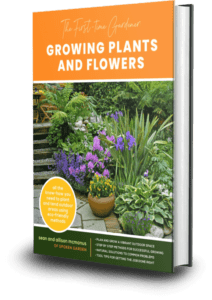What You’ll Learn:
- The 7 different kinds of Begonias
- Is your garden in the right hardiness zone to grow begonias?
- Where you can go to buy your own begonias
The 7 Different Kinds of Begonias
Did you know there are 7 different kinds or groups of begonias? Yep, there are sooo many to choose from!
We published a YouTube video about “Want Shade Loving Perennials That Bloom During Summer?” where different audience members were trying to tell us that begonias, especially the tuberous begonias we had in the video, were only annuals.
The video is below if you want to watch it for shade perennials and inspo!
So, we wanted to take this opportunity to let everyone know that most begonias are actually perennials, it’s just that they need to be hardy where you live as a perennial.
Most begonias are sold in the US as annual plants and then discarded in the fall months.
Once the night time temperatures reach below 50F, most begonias won’t survive, let alone a light frost, so they are grown as an annual plant in northern and colder climates.
But, if you grow them in containers, you can always bring them inside or into a protected, heated areas to continue to grow over the coldest months and still enjoy them.
With all that, here are the 7 different kinds or groups (in no particular order) of begonias that you might be able to grow in your garden (or indoors):
- Semperflorens group, which includes wax-leaf begonias. These begonias are actually perennial, soft stemmed, succulent evergreen plants that are grown as annual bedding plants in northern climates. Flowers can be single or doubles. They like to grow in full sun or partial shade and need well-draining soil.
- Tuberous group are begonias that will go dormant during the winter months in colder climates (cold hard in zones 8-10) and will then start growing in mid spring to early summer to flower into early fall months. These can have single, semidouble, and double flowers and prefer dappled shade and moist conditions.
- Shrub-like group are evergreen, perennial begonias with hairy leaves and stems. They mainly produce single flowers and like to grow in partial sun with well-draining soil.
- Winter Flowering group, which are evergreen low growing compact perennials that have thin succulent stems and are often included with tuberous begonias. They come in single and double flowers from late fall to mid spring, with green or bronze leaves. They prefer indirect sun and moist soil.
- Rex group, which are mostly evergreen and rhizomatous perennials that can be varied in their growth habit and like partial shade and well-draining soil, AND water sparingly.
- Cane-stemmed group, which are evergreen and woody perennials that are known as “Angel Wings” that have an upright growth habit with large pendulous panicle flowers. They like filtered direct sunlight and do best in well-draining potting mixes that are loam-based. These plants will need to be staked.
- Rhizomatous group, which are mostly evergreen perennials that grow from a rhizome. They are specifically grown for their foliage and for their brightly colored single flowers. Their growth habit varies so you can find them growing upright or more low growing spreaders. They prefer partial shade and well-draining soil, but watering sparingly as these begonias don’t like to grow in constantly wet conditions.
It’s important to note that pretty much all these begonias are susceptible to the disease Botrytus, so do not let any water sit or stand on your begonias leaves or they will develop this or another kind of fungal infection.

If you are looking to add begonias to your garden, Eden Brothers carries a great assortment of tuberous begonias, including single and double flower varieties.
Make sure to check them out by following the link in this episodes description and use the coupon code: SPOKENGARDEN at checkout for 15% off your purchase.
Thanks for Listening!
our podcast page by clicking here or go to SpokenGarden.com and click on the “Listen” tab. Also find us on your favorite podcast platform and smart speaker!









